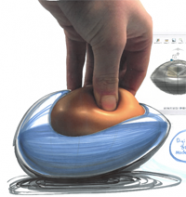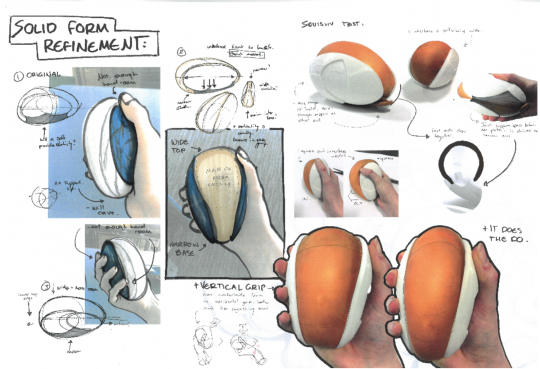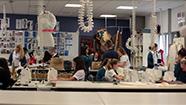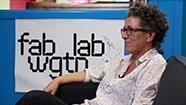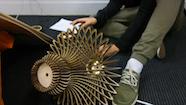Top scholar DVC: Digital modelling tool

Freeform
Tessa van den Beuken designed a unique product called Freeform, a computer input device for graphic designers and artists.
The digital modelling device lets a designer or artist use their hands to sculpt, as you would with a physical sculpture, and transfers this information to a computer.
Research and ideation
Year 13 DVC students at Wellington Girls’ College begin their product design project with the open-ended scenario:
- ”Design a bespoke product to help a designer of your choice do what they do best – design”
Tessa was interested in how designers and artists worked, including the tools used and the strengths and weaknesses of these. Many designers are in transition between using traditional tools, such as pens and pencils, and digital tools. Speed and efficiency while being creative is one of the big challenges for a good designer.
Tessa began by interviewing designers, including university design lecturers and students, design teachers, and DVC students at her school. She asked questions about how they worked, how they arranged their desks, and what annoyed them about their working space and its tools.
Examining and analysing her own workspace and tools that she used as a designer helped focus her ideas.
Tessa explored a number of phrases and words that encompassed what designers saw as hurdles when designing.
Design and modelling
As well as her initial research and ideation, Tessa modelled Freeform.
- Layers of foam board and paper were glued together and then translated into computer models.
- The squishy aspect of Freeform was created using flour in a balloon.
- This initial prototype was exhibited at the annual school exhibition of student work.
Tessa notes that it was interesting watching how people reacted to the Freeform prototype. They wanted to pick it up and think about what it would be like to use. This consistent engagement confirmed for Tessa that she was going in the right direction with her design ideas.
Visual techniques
Tessa uses figure drawing to express function and emotion. She considers Dynamic Figure Drawing by Burne Hogarth a great reference.
- The majority of her sketches were created in grey marker pens, then rendered in biro. Using marker eliminated any temptation to erase or feather outlines thus speeding up her design process.
- Printing photos of herself squishing Freeform, loading into Photoshop and then digitally drawing over, eliminated time taken to draw out hands from scratch.
- Digital collaging was another technique Tessa used effectively. Shapes were drawn in biro, scanned into Photoshop and then moved, enlarged, and reduced. This technique gave her total control over such things as emphasis in design and layout of a page, and to adapt how the design narrative read.
Portfolio design story
Convincing communication is one of the performance standards for DVC scholarship.
Tessa carried out a lot of diverse exploration of design ideas for her product. Her portfolio was then established by sorting out the priorities for material to be included. This ensured that it could be read as a collective, coherent design story.
Being hungry for feedback on the design story and seeking this at significant times was also seen as key to Tessa’s success. Tessa had already had success with DVC scholarship in year 12.
See a clip of viewing the portfolio.
The final portfolio was set up to engage other senses in addition to sight.
- The sense of touch reflecting a key aspect of the Freeform product.
- Die cuts and transparent paper helped lead the viewer through the design story.
- Fold outs broadened the canvas to a wide screen format and required the viewer to interact with the portfolio.
Future developments
Tessa has already considered other possibilities for her product – What if Freeform could project an image onto an object?
Tessa’s own future plans include attending a design or engineering school.
Related videos
A technology department with a digital and design focus (04:13)
Julie Clement shares how a design focus has engaged her students.
What’s happening at the Fab Lab (02:04)
Wendy Nealle describes the Fab Academy qualification and how digital fabrication – makerspaces and hackerspaces – opens up opportunities for students....
Studying industrial design (03:33)
Kimi Whiting shares her experience of transitioning from year 13 to studying design at university.

